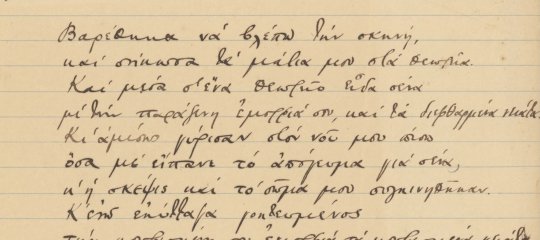Μεταφραστικές δραστηριότητες του Τμήματος Νέων Ελληνικών του Παν/μίου της Λουντ
Νίκος Δομαζάκης
11 Ιουνίου 2007
Μεταφραστικές δραστηριότητες του τμήματος Νέων Ελληνικών του Παν/μίου της Λουντ
 Κυκλοφόρησε πρόσφατα, από τον εκδοτικό οίκο Sekel της Λουντ, η σουηδική μετάφραση του βυζαντινού έπους του 12ου αιώνα Βασίλειος Διγενής Ακρίτης[1].
Κυκλοφόρησε πρόσφατα, από τον εκδοτικό οίκο Sekel της Λουντ, η σουηδική μετάφραση του βυζαντινού έπους του 12ου αιώνα Βασίλειος Διγενής Ακρίτης[1].
Η μετάφραση, που βασίζεται στην έκδοση του χειρογράφου του Εσκοριάλ από τον Στυλιανό Αλεξίου[2], υπογράφεται από τον Βασίλη Σαμπατακάκη, λέκτορα Νέων Ελληνικών στο Πανεπιστήμιο της Λουντ, και τον Staffan Stolpe, συγγραφέα, μεταξύ άλλων, βιβλίων για την αρχαία και τη νεότερη Ελλάδα.
Η έκδοση περιλαμβάνει: α) εισαγωγή από τον Β. Σαμπατακάκη, στην οποία παρουσιάζεται συνοπτικά το ιστορικό πλαίσιο του έργου, η παράδοση του κειμένου, η γλώσσα και η μετρική, και δίνεται περίληψη του έπους, β) το κείμενο της έκδοσης Αλεξίου με παράλληλη έμμετρη σουηδική μετάφραση, γ) σημειώσεις και επιλογή βιβλιογραφίας.
Είναι η δεύτερη φορά που ο Βασίλειος Διγενής Ακρίτης μεταφράζεται στα σουηδικά. Είχε προηγηθεί, to 1940, η βασισμένη στο χειρόγραφο της Κρυπτοφέρρης μετάφραση του S. Lindstam[3].
Η καλαίσθητη έκδοση πραγματοποιήθηκε χάρη στην υποστήριξη του Ιδρύματος Crafoord και του Ιδρύματος Ουράνη.
Επίσης, το Τμήμα Νέων Ελληνικών του Παν/μίου της Λουντ, ανταποκρινόμενο σε αίτημα του Διεθνούς Κέντρου Λογοτεχνών και Μεταφραστών Ρόδου, ανέλαβε να μεταφράσει στα σουηδικά δείγματα γραφής έξι σύγχρονων ελλήνων πεζογράφων.
Για τον σκοπό αυτό πραγματοποιήθηκαν υπό την ευθύνη των διδασκόντων τρία μεταφραστικά σεμινάρια, στα οποία συμμετείχαν παλαιότεροι και νεότεροι φοιτητές του τμήματος, που ανέλαβαν τη μετάφραση των ιδιαίτερα απαιτητικών κειμένων.
Συγκεκριμένα, ο Βασίλης Σαμπατακάκης μετέφρασε δύο διηγήματα από τη συλλογή Ο καθρέφτης του τυφλού του Αχιλλέα Κυριακίδη (Πόλις 2005) και αποσπάσματα από το μυθιστόρημα Επικράνθη, δια χειρός Αλέξη Ραζή της Νίκης Αναστασέα (Κέδρος 2006), η Barbro Gierow ένα απόσπασμα από το Σουέλ της Ιωάννας Καρυστιάνη (Καστανιώτης 2006), η Karin Bauman ένα κεφάλαιο από το μυθιστόρημα της Μαρίας Γαβαλά Τα κορίτσια της πλατείας (Πόλις 2006), ο Erik Sjöberg αποσπάσματα από το μυθιστόρημα Η μανία με την Άνοιξη του Άρη Μαραγκόπουλου (Ελληνικά Γράμματα 2006) και η Monica Nilsson ένα απόσπασμα από τη νουβέλα της Ελένης Λαδιά Η γυναίκα με το πλοίο στο κεφάλι (Βιβλιοπωλείον της Εστίας 2006).
Τα παραπάνω βιβλία και οι συγγραφείς τους παρουσιάστηκαν από το Ευρωπαϊκό Κέντρο Μετάφρασης Λογοτεχνίας (Ε.ΚΕ.ΜΕ.Λ.) στην 4η Διεθνή Έκθεση Βιβλίου Θεσσαλονίκης (17-20 Μαΐου 2007).
Νίκος Δομαζάκης
[1]Vassilios Digenis Akritis/ Βασίλειος Διγενής Ακρίτης, Översättning av Vassilios Sabatakakis och Staffan Stolpe, Sekel Bokförlag, 2007.
[2]Βασίλειος Διγενής Ακρίτης (κατά το χειρόγραφο του Εσκοριάλ) και το άσμα του Αρμούρη. Κριτική έκδοση, Εισαγωγή, Σημειώσεις, Γλωσσάριο Στυλιανού Αλεξίου. Ερμής, Αθήνα 1985, β΄εκδ. 2006.
[3]Det bysantinska eposet omDigenis Basileios Akritas, översättning jämte en inledning av S. Lindstam, Göteborg 1940.
- Εισέλθετε στο σύστημα για να υποβάλετε σχόλια










